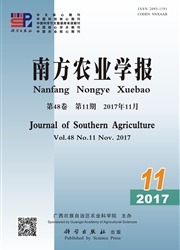

 中文摘要:
中文摘要:
【目的】发掘出一批玫瑰SNP候选位点,为进一步开发玫瑰EST-SNP标记及研究玫瑰遗传背景、相关性状的分子标记等打下基础。【方法】从美国国立生物技术信息中心(NCBI)的db EST数据库下载27125条玫瑰EST序列,经生物信息学方法分析,发掘玫瑰EST-SNP位点,并对其所在核苷酸序列进行功能注释分析。【结果】对27125条EST进行拼接,共得到3544条重叠群(Contigs),其中有243个Contigs含有SNP候选位点。从中筛选出224个候选EST-SNP位点,其碱基突变类型中转换和颠换的数量分别占SNP候选位点总数的59.8%和27.2%。通过序列比对分析,发现有22个SNP位点来源于蔷薇科植物(与玫瑰同科),其中来源于野草莓的基因最多(8个),另有15个SNP位点所在的EST序列与某些软体动物门物种的基因具有较高同源性。【结论】NCBI中的玫瑰EST数据库数据庞大,足够发掘出大量的SNP标记,使得以EST-SNP对蔷薇科玫瑰等植物进行品种鉴定、分类、遗传多样性分析具有可行性。
 英文摘要:
英文摘要:
【Objective】The present experiment was conducted to discover a number of Rosa rugosa SNP candidate sites, in order to lay the foundation for further developing R. rugosa EST-SNP markers, and studying genetic background of R. rugosa and molecular markers of its related traits. 【Method】A total of 27125 R. rugosa EST sequences were downloaded from the db EST database of National Center of Biotechnology Information(NCBI). Then R. rugosa EST-SNP sites were investigated, and its nucleotide sequences were analysed by bioinformatics methods. 【Result】The results showed that,a total of 3544 contigs were obtained by splicing 27125 EST sequences, and 243 of which contained SNP candidate sites.And 224 EST-SNP candidate sites were selected from them, and the numbers of base transition and transversion in base mutation accounted for 59.8% and 27.2% of total number of SNP candidate sites, respectively. Through sequence alignment analysis, it was found that 22 SNP sites were derived from Rosaceae plants(belonging to the same family with R.rugosa), 8 of which were derived from Fragaria vesca gene, and EST sequences with 15 SNP sites shared higher homology with genes of some Mollusca animals. 【Conclusion】There are a large amount of R. rugosa EST data in NCBI database,thus a large number of SNP labelled can be discovered, and it is feasible that Rosaceae rose plant varieties are identified and classified, and its genetic diversity are determined based EST-SNP analysis.
 同期刊论文项目
同期刊论文项目
 同项目期刊论文
同项目期刊论文
 期刊信息
期刊信息
